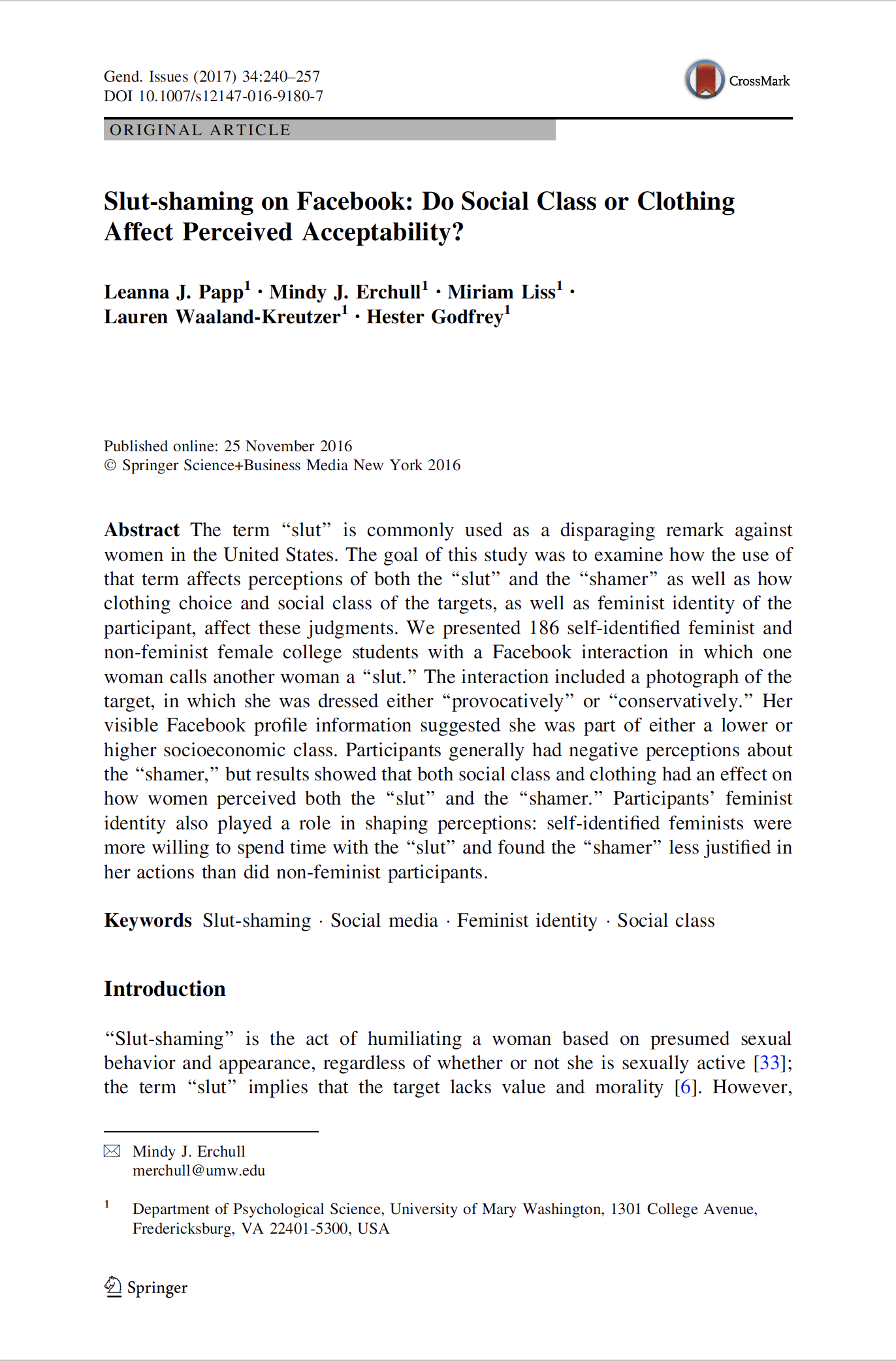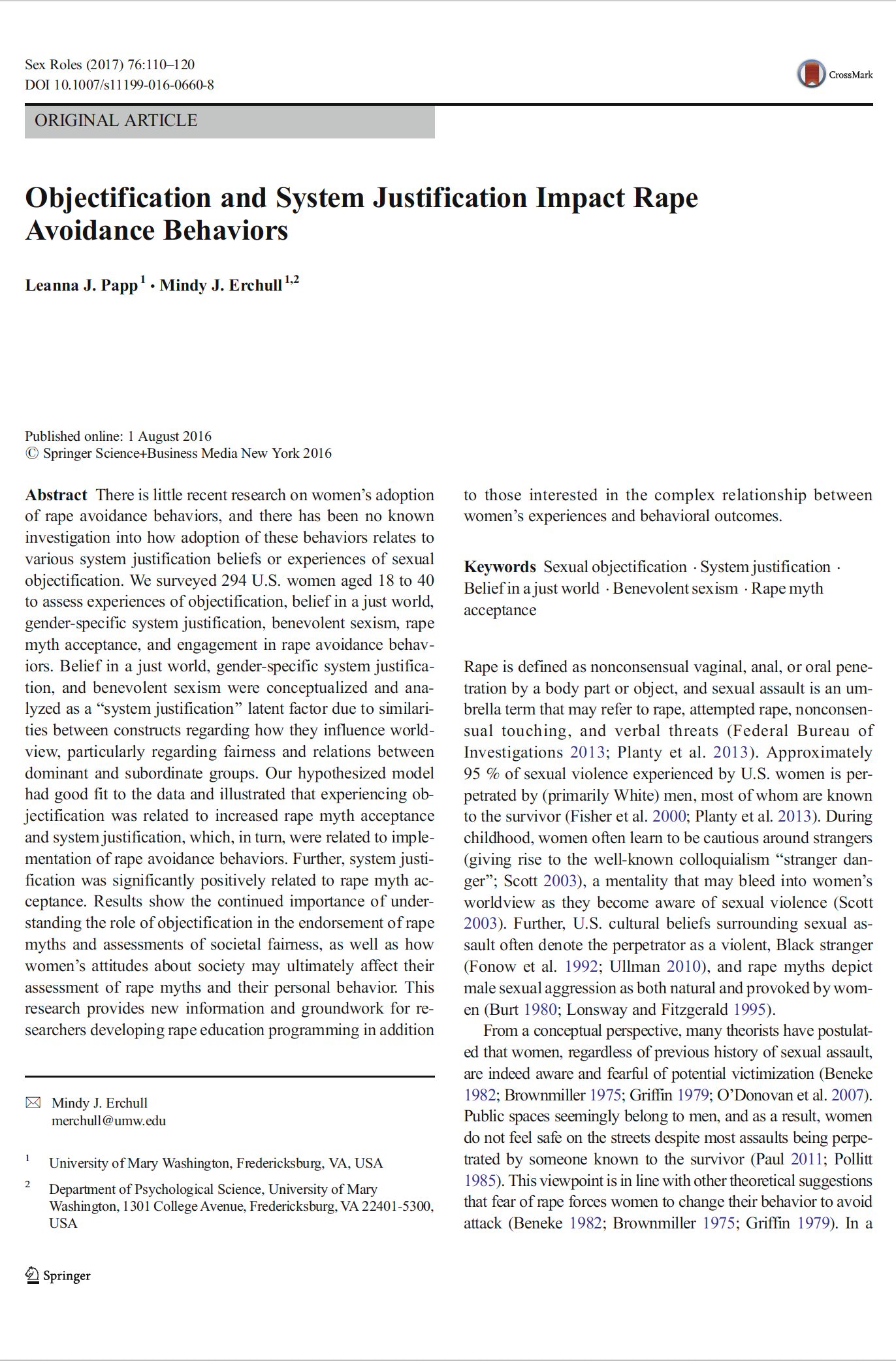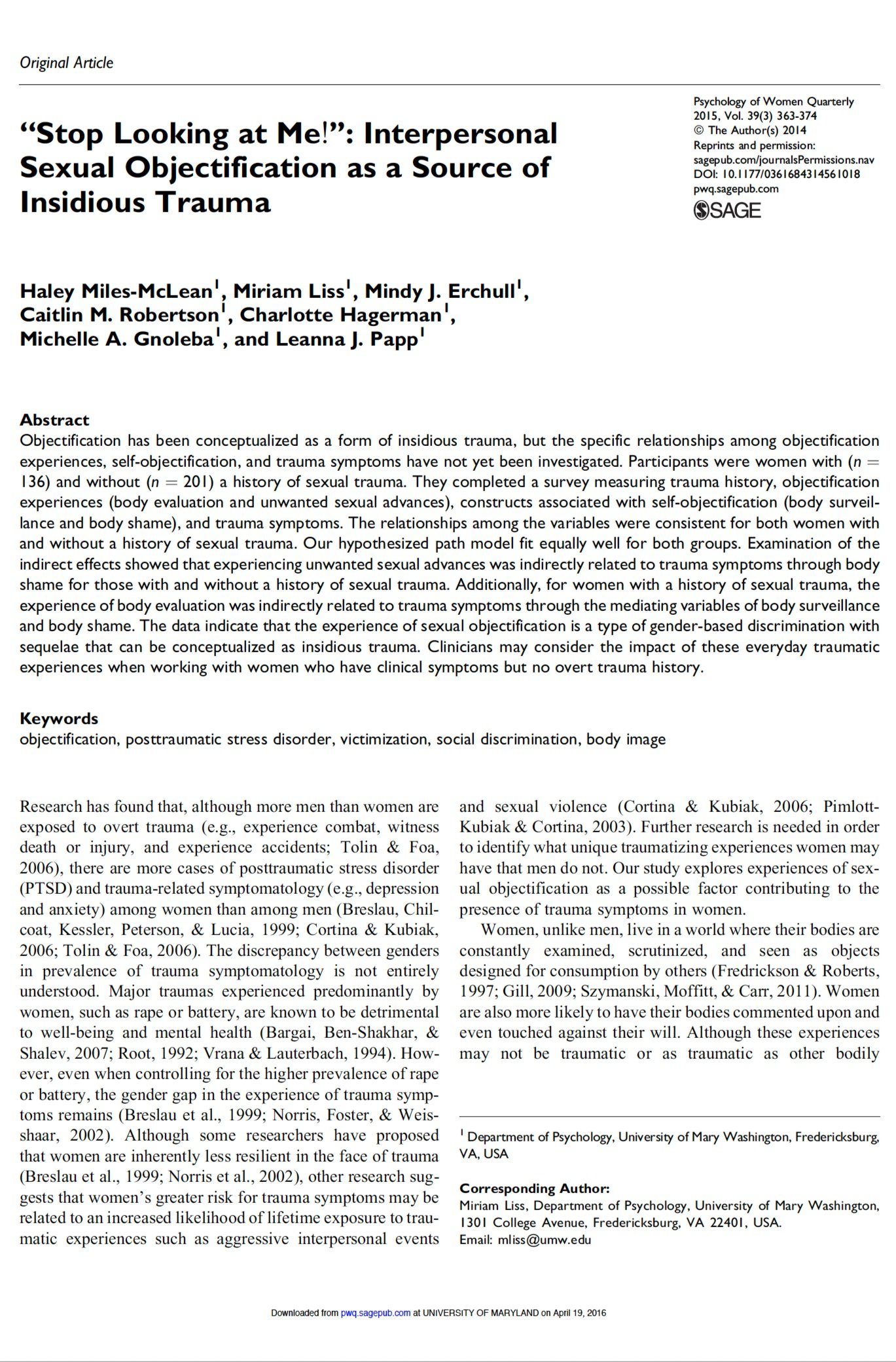CURRENT RESEARCH INTERESTS
-
My primary expertise is in sexual violence, particularly as it occurs on campus and in drinking settings. I developed the term sexualized aggression to home in on understudied forms of sexual assault and aggression. Sexualized aggression refers to non-consensual sexual contact that occurs without warning (e.g., groping) and aggressive tactics (e.g., guilt, anger) that don’t necessarily end in non-consensual contact. My main line of research focuses on how sexualized aggression appears and is appraised in social drinking settings like parties, bars, and clubs. Prior research has indicated that sexualized aggression is common in young women’s social lives (e.g., Papp & McClelland, 2021). Repeated coercion and intrusions to personal space can have a tangible impact on women’s sense of belonging in public spaces and development of healthy expectations for sex and intimacy.
My research also considers the implications of policies and laws for people’s understanding of violence. Institutional sexual misconduct policies, for example, offer a direct window into an organization’s values. There is a remarkably high number of terms in circulation—more than 100!—that refer to non-consensual sexual contact in university sexual misconduct policies alone (Papp et al., 2023). Contradictions between and within schools’ policies regarding what constitutes sexual assault can have meaningful implications for societal-level, shared understandings of sexual violence and adjudication at individual institutions.
-
Misinformation and stigma surrounding reproductive health care are produced at the individual, interpersonal, organizational, community, and policy levels. My current research in this area is focused on the psychological, sexual, and political implications of restrictions to reproductive health-related medical services.
-
Measuring complex attitudes requires attention to how sociopolitical power and social context shape the way people interpret and respond to researchers’ questions. My research has explored how to best assess anti-Black racism, sexism, and women’s experiences and perceptions of everyday sexual violence (e.g., Davis et al., 2023).
-

Where boys learn to be men: Associations between media use and male adolescents’ gender beliefs and well-being
… The present study explored associations between consumption of three media genres that frequently feature men, endorsement of traditional gender roles, and mental health for a sample of Black, Asian American, and White male adolescents. Multigroup modeling indicated significant associations between media consumption and endorsement of traditional gender roles for all three groups and a significant association between traditional gender roles and mental distress among Asian American and White male adolescents. Results suggest that media may be a powerful force in young men’s gender beliefs and mental health regardless of racial background. …
-

The Symbolic Racism Scale and the Modern Sexism Scale: Testing measurement invariance in diverse samples
… To establish measurement equivalence across racial/ethnic (Black, Latinx, and white) and gender (women and men) groups, we conducted a measurement invariance analysis of the SRS and the MSS in a large, diverse sample (N = 719). … The MSS was noninvariant across racial/ethnic groups. Partial invariance testing revealed nonequivalent factor loadings between Black and Latinx participants compared to white participants on an item of the MSS that referenced “unwarranted” attention that women receive from the government and media. … Future research is needed to assess how the item is interpreted by Black and Latinx people so it can be modified for use in these communities. …
-

How many terms does it take to define sexual assault? Inconsistencies in U.S. higher education sexual misconduct policies
Campus sexual misconduct policies (SMPs) outline prohibited conduct. We sought to document the range of terms used to refer to forms of nonconsensual sexual contact in SMPs and to analyze the content of definitions provided for the term “sexual assault.” We coded the 2016-2017 SMPs from a sample of 381 U.S. schools. We identified 125 unique terms and documented both a terminological and conceptual morass around sexual assault. Policy language may have implications for students’ and administrators’ evaluation of experiences and reports of sexual assault.
-

Abortion stigma: Imagined consequences for people seeking abortion care in the U.S.
… To examine the concept and characteristics of abortion stigma, we interviewed 55 individuals about whether they thought there should be consequences for getting an abortion and, if so, what the consequences should be. Adults from three states (Michigan, Kansas, and Arizona) were purposively sampled to include a range of abortion identities and levels of religious engagement. We used reflexive thematic analysis to code and interpret the data. Participants imagined consequences including financial penalties, incarceration, and forced sterilization. Three themes highlighted how abortion was described as violating the law, women’s gender roles, and religious doctrine; accordingly, abortion was imagined as deserving of negative consequences, although abortion was legal in all states during data collection. …
-

Sara McClelland (encyclopedia entry)
This encyclopedia entry appeared in The Palgrave Encyclopedia of Sexuality Education, edited by Louisa Allen and Mary Lou Rasmussen.
Sara I. McClelland, Ph.D. (b. 1970) is a feminist psychologist who uses critical theories and methods to interrogate the role of policy and law in sexuality education and sexual development, evaluations, and expectations. Across all lines of research, McClelland prioritizes the translation of theories, methods, and empirical findings to a wide variety of audiences, including policymakers, healthcare providers, and educational leadership. Across domains, she is committed to understanding how social and political landscapes shape what individuals see as possible, hoped for, and deserved. In this entry, we trace McClelland’s intellectual development and her contribution to critical theories and methods. -

Contributions of reality TV consumption to college women’s endorsement of the heterosexual script and acceptance of sexualized aggression
… In Study 1, 466 undergraduate women indicated their support of the heterosexual script and their consumption of popular reality programs, sitcoms, and dramas. Heavier viewing of reality programming predicted greater support for the heterosexual script, and heavier viewing of sitcoms predicted weaker support. In Study 2, we used longitudinal data to explore relations between viewing reality television, acceptance of the heterosexual script, and acceptance of sexualized aggression during undergraduate women’s first 2 years in college (N = 244). We found that reality television consumption was not a direct predictor of acceptance of sexualized aggression but was a significant, indirect predictor through endorsement of the heterosexual script. …
-

Too common to count? “Mild” sexual assault and aggression among U.S. college women
… We aimed to document the characteristics of “mild” sexual assault and aggression that college women experience at large parties and bars. In addition, we considered women’s descriptions of assaultive and aggressive incidents in the context of campus climate survey items to evaluate the potential for measurement gaps. Across six focus groups (N = 36) at a large, public university in the midwestern U.S., women described routine experiences of “mild” sexual assault and aggression, so common that often only imprecise counts of their frequency (e.g., “all the time”) were possible. Our findings document the many forms and frequencies of “mild” assault and aggression in college women’s lives, as well as the limits of campus climate surveys in measuring the mundane sexual mistreatment of women in campus life. We develop the term “sexualized aggression” to capture such mistreatment and situate this concept within the larger body of research on campus sexual violence.
-

Slut-shaming on Facebook: Do social class or clothing affect perceived acceptability?
The term ‘‘slut’’ is commonly used as a disparaging remark against women in the United States. The goal of this study was to examine how the use of that term affects perceptions of both the ‘‘slut’’ and the ‘‘shamer’’ as well as how clothing choice and social class of the targets, as well as feminist identity of the participant, affect these judgments. We presented 186 self-identified feminist and non-feminist female college students with a Facebook interaction in which one woman calls another woman a ‘‘slut.’’ The interaction included a photograph of the target, in which she was dressed either ‘‘provocatively’’ or ‘‘conservatively.’’ Her visible Facebook profile information suggested she was part of either a lower or higher socioeconomic class. Participants generally had negative perceptions about the ‘‘shamer,’’ but results showed that both social class and clothing had an effect on how women perceived both the ‘‘slut’’ and the ‘‘shamer.’’ Participants’ feminist identity also played a role in shaping perceptions: self-identified feminists were more willing to spend time with the ‘‘slut’’ and found the ‘‘shamer’’ less justified in her actions than did non-feminist participants.
-

Objectification and system justification impact rape avoidance behaviors
… We surveyed 294 U.S. women aged 18 to 40 to assess experiences of objectification, belief in a just world, gender-specific system justification, benevolent sexism, rape myth acceptance, and engagement in rape avoidance behaviors. Belief in a just world, gender-specific system justification, and benevolent sexism were conceptualized and analyzed as a “system justification” latent factor due to similarities between constructs regarding how they influence worldview, particularly regarding fairness and relations between dominant and subordinate groups. Our hypothesized model had good fit to the data and illustrated that experiencing objectification was related to increased rape myth acceptance and system justification, which, in turn, were related to implementation of rape avoidance behaviors. Further, system justification was significantly positively related to rape myth acceptance. Results show the continued importance of understanding the role of objectification in the endorsement of rape myths and assessments of societal fairness, as well as how women’s attitudes about society may ultimately affect their assessment of rape myths and their personal behavior. …
-

The dark side of heterosexual romance: Endorsement of romantic beliefs relates to intimate partner violence
… The current study explored three types of romantic beliefs among women: endorsement of the ideology of romanticism, highly valuing romantic relationships, and the belief that jealousy is good. The goal was to determine whether these beliefs would be related to finding controlling behaviors romantic as well as to reported experiences of both physical and psychological intimate partner violence (IPV).We surveyed 275 heterosexual-identified women, aged 18 to 50, and measured their endorsement of romantic beliefs, the extent to which they romanticized controlling behavior, and experiences of physical and psychological abuse within their current or most recent romantic relationship. Romantic beliefs were related to romanticizing controlling behaviors, which, in turn, was related to experiences of IPV. There was also a significant indirect relationship between romantic beliefs and experiences of IPV. The data indicate that seemingly positive romantic ideologies can have insidious negative effects. …
-

“Stop looking at me!”: Interpersonal sexual objectification as a source of insidious trauma
… Participants were women with (n = 136) and without (n = 201) a history of sexual trauma. They completed a survey measuring trauma history, objectification experiences (body evaluation and unwanted sexual advances), constructs associated with self-objectification (body surveillance and body shame), and trauma symptoms. The relationships among the variables were consistent for both women with and without a history of sexual trauma. Our hypothesized path model fit equally well for both groups. Examination of the indirect effects showed that experiencing unwanted sexual advances was indirectly related to trauma symptoms through body shame for those with and without a history of sexual trauma. Additionally, for women with a history of sexual trauma, the experience of body evaluation was indirectly related to trauma symptoms through the mediating variables of body surveillance and body shame. The data indicate that the experience of sexual objectification is a type of gender-based discrimination with sequelae that can be conceptualized as insidious trauma. …
-

Exploring perceptions of slut-shaming on Facebook: Evidence for a reverse sexual double standard
Although there is a widespread belief that women are judged more harshly for sexual activity than men, research on the existence of the sexual double standard has been mixed. We investigated the sexual double standard and ‘‘slutshaming’’ by asking participants to provide perceptions of both a target of ‘‘slutshaming’’ and a ‘‘shamer.’’ Male and female participants viewed a blinded Facebook conversation in which the male or female target, or ‘‘slut,’’ was shamed by either a male or female ‘‘shamer.’’ We found evidence for a reverse sexual double standard; male ‘‘sluts’’ were judged more harshly. Furthermore, the ‘‘shamer’’ was negatively evaluated, especially when shaming a woman. Our participants also indicated a belief in a societal sexual double standard. They perceived the ‘‘shamer’’ to be more judgmental and less congratulatory when the ‘‘slut’’ was female. Furthermore, qualitative data indicated that female ‘‘sluts’’ were believed to be labeled as such for lower levels of sexual behavior (e.g., sexy clothing or dancing), than was the case for male ‘‘sluts’’ (e.g., sex with multiple partners). Our data indicate that individual beliefs are changing more quickly than social perceptions.